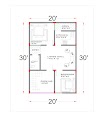18 BY 50 FEET 2BHK HOUSEPLAN WITH CAR PARKING|18*50 FEET HOUSE MAP|18 X 50 FEET HOUSE DESIGN
If you are looking for complete details for the plot size of 18 feet by 50 feet then you are in the correct place. We building plan provides you the best plan with all the required information including floor plan, structural detail plan with the complete construction procedure. In this article you will find almost all the information and the data in the pdf format regarding the 18 by 50 house plan.
DOWNLOAD THE PDF FILES:
2D CONCEALED BEAM LAYOUT-CLICK HERE
2D PLAN:
The above image shows the 2d floor plan which is going to be implemented in the plot of size 18 by 50 feet. This house has 2 bedroom with the attach toilet facility, kitchen with the separate wash area, living hall with separate open area. Totally 3 open space are provided for this plot. Open space is provided for the proper ventilation which is compulsory for both the light and fresh air circulation. The measurements of the each block is clearly mentioned in the plan itself one can easily understand the plan.
STRUCTURAL DETAILS:
 |
COLUMN LAYOUT |
 |
PLINTH BEAM LAYOUT |
 |
| CONCEALED BEAM OR HIDDEN BEAM LAYOUT |
All the required structural details are provided above with the images, Column layout gives you the idea about the column placement [where the column is going to place in the plot] with the required place and distance for proper load distribution from the structure to the ground surface, plinth beam layout can be used to place the beam between the load acting above the beam [ wall ] and the load to the ground [foundation]. Concealed beam layout shows you the place where the beam must be placed during the slab concrete work. Hidden beam also called as concealed beam since the size of the beam is equal to the size or thickness of the moulding slab.
10 mm diameter bar with 6 inches c/c distance spacing can be used as main bar where 10 mm diameter bar with 7 inches c/c spacing can be used as the distribution bar for the slab bar bender work. Slab thickness can be 5-6 inches. More thickness more will be the dead load and more load to the column which will be dangerous.
Construction Procedure:
Structural work or Civil Work
The first process is cleaning, measuring the site properly and borewell work . Once site is measured then the next step will be marking the column pits and after marking the excavation will takes place in which column will be erected as per planned. Excavation can be done by using man power or jcb. After finishing the concrete work of the column the pits should not be backfill immediately it should allow for curing once curing is done then pits can be backfilled with the soil which was excavated.
Once the columns are placed and cured properly then plinth work will takes place. Plinth will be provided in the required position as per the plan for the plinth work bar bender will first complete his work once bar bander work is completed formwork needs to be provided and then concrete will be poured on it after completing the concrete work of the plinth beam, brick work will start
During the brickwork the open space will be provided in place of the doors and windows. Lintel beam will be provided at the 7 feet height. Then after concreting the lintel beam the walls will be levelled for moulding height [ generally 10 or 11 feet ] 11 feet floor height is provided if false ceiling is going to design for the ceiling as it provide a beautiful look to the ceiling.
Once wall is levelled for the required moulding height then the formwork will occur in which all the moulding area will be covered by using the Scaffolding but the open space don't need any formwork.
after the formwork bar bender work will takes place in which bar required for the slabs and concealed beam will be provided after completing the bar bender work concreting will be done.
The curing plays a very important role in providing the required strength to the molding slab curing must be done for 28 days since concrete attains maximum strength after the curing period of 28 days. and till that the formwork should not be removed After the curing process the formwork can be removed and concealed electricity pipe and concealed water pipe needs to be provided before the plastering work. After placing the pipe plastering can be start and it should also cured properly otherwise the air cracks will be developed.
Drainage pipe work is the most important work of any building since it washes out all the water and solid wastes from the bathrooms, upper terrace, kitchen and from the other required place. Drainage needs to be done very carefully and watchfully.
Finishing work:
Civil work gets completed till the plastering and drainage work once plastering is done the civil work is completed and we can move to the finishing work
Wall Putty work is carried by the painter in which the painter will use the putty to level the wall and ceiling surface properly. After the putty work tiles work takes place. Before laying tiles check for water leakage and drainage work since it will be more difficult to find out the route of leakage once tiles are laid.
After tiles laying process door fitting work, final paint work, staircase railing work, wiring work, motor fitting work, sanitary fitting works, switches fitting work, window fitting work, light fitting work and other interior works take place all the fitting works will be carried by electrician , plumber, carpenter, fabricator and painter. availability of all this labor plays a very important role this is the main reason for completing a project delays.
Caution:
Never allow the painter or tiler [ tiles laying labor] to use the drainage pipes to clean their equipment or buckets since this is the main reason for further future blockage in the drainage system.





